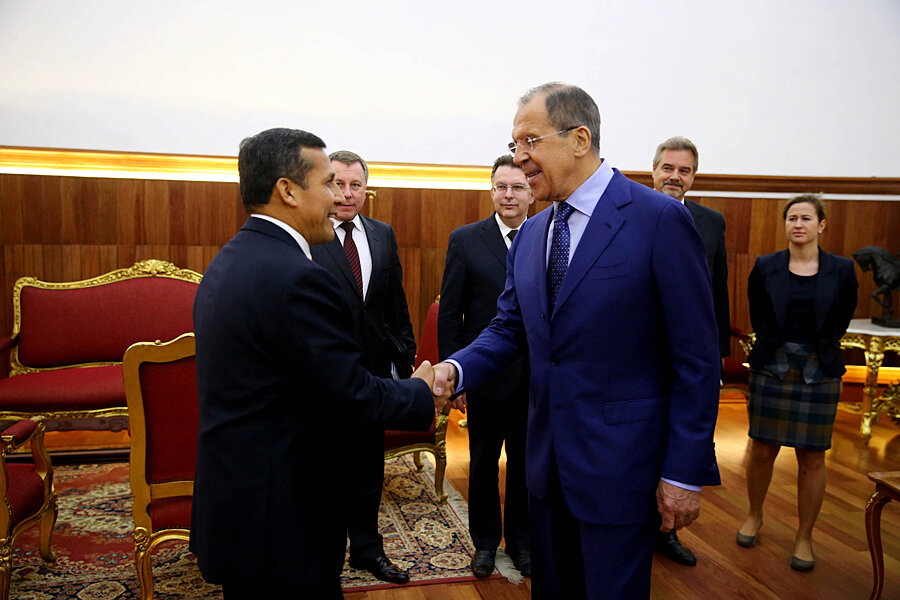As Russia pivots to Asia, some ask how far east it's willing to look
Loading...
| Lima, Peru
Russian President Vladimir Putin’s trip to China to sign a 30-year energy deal may signal a major shift for his country toward Asia, but in some parts of Latin America, the hope is that Russia’s pivot will be more extensive, encompassing the broader Asia-Pacific region.
Chile and Peru, with the longest Pacific coastlines in South America, are already lined up in the case that Russia decides to cast a wider net. They have approached Russia about the possibility of negotiating free-trade agreements, and Peru is pushing a list of investments, including the possibility of hosting a Russian helicopter maintenance facility for the region, attracting Russian investment in the country’s growing natural gas sector, and signing bilateral deals on education, science, and anti-narcotics.
Russia, for both countries, is a “last frontier” when it comes to trade relations. Chile and Peru have free-trade agreements with the world’s major economies, including China, Japan, the European Union, and the United States. Russia is the only large member within the 21-economy Asia-Pacific Economic Cooperation (APEC) forum with which Chile and Peru do not have stellar commercial ties.
There’s a diplomatic hurdle to closer ties, created by votes by both countries in the United Nations in March against Russia’s move to annex Crimea from Ukraine. But perhaps a bigger political factor looming in the background is Moscow’s sense that Chile and Peru, particularly the former, are too cozy with the United States.
“Russia sees Chile as a staunch ally of the US government, so the general sentiment is that Russia would be wasting time focusing attention on Chile,” says Jose Luis Ibáñez, an international relations expert in Chile.
More about politics than economy?
Chile and Russia announced plans to discuss improving economic ties at a meeting in Moscow this June, and recently inaugurated President Michelle Bachelet has extended an invitation for Putin to visit Chile later this year. The two would visit research centers in Antarctica if Putin were to accept.
Chile’s exports to Russia last year were $654 million, a 54-percent increase from the previous year, but still only 0.8 percent of its total exports. Russia’s exports to Chile were $55 million last year. Though a visit by Russian Foreign Minister Sergey Lavrov late last month raised some hopes of renewed attention from Russia in Latin America, Ibáñez says his trip had more to do with Chile’s March 27 vote in the United Nations to reject Crimea’s referendum to separate from Ukraine.
“Lavrov is not a lightweight. I can’t imagine that he came here to talk about trade,” says Ibáñez. There were public statements concerning trade and the possibility of Chile acquiring Russian-made weapons during the visit, however. Mr. Lavrov also made stops in Cuba, Nicaragua, and Peru.
Peru also voted for the UN resolution recognizing Ukraine’s territorial integrity. Lavrov’s visit to Peru coincided with the 45th anniversary of diplomatic ties between the two countries, but Peru’s former Foreign Minister Francisco Tudela agrees with Ibáñez that the motivation was about making nice after the Crimea vote.
The Peruvian government, like Chile, played up the need for a free-trade agreement with Russia. Peru has been lobbying hard for this since President Ollanta Humala took office in July 2011, but little has happened. Peru-Russia trade, while growing, remains negligible. Bilateral trade last year was $726 million, up more than 50 percent from 2012. Russia has the edge, exporting $585 million to Peru in 2013.
What Peru is really pining for, analysts say, is the arrival of Russian gas companies. Peru’s oil and gas agency, Perupetro, said May 15 that Russian state-owned Gazprom was interested in taking part in the construction of a new gas pipeline that could eventually lead to a second LNG plant in the country for export to Asia. Peru will reveal the winning bid at the end of next month, with a joint bid expected from Gazprom, China National Petroleum Corp. and Italy’s Saipem, as well as bids from two other Russian companies interested in oil and gas exploration in Peru.
Simon Pirani, an expert on Russia at the Oxford Institute for Energy Studies, says that if Gazprom were to get involved in Peru, the move would be more political than economic.
“Gazprom’s main strategic issue now is opening up the Chinese market,” he says.
Russia and China today announced a $400 billion gas supply deal. A $4 billion project in Peru is not in the same ballpark, Mr. Pirani says. “Investments in Latin America and Africa tend to be prestige projects that have more to do with what the Foreign Ministry is working on and really not part of Gazprom’s core business.” he says.
“The world is pivoting to Asia and it would not make any sense for Russia to do anything different…. There is a chance of a free-trade agreement with Peru, but I think we will see Russia focus more on strategic partnerships in Asia,” Mr. Tudela says.







